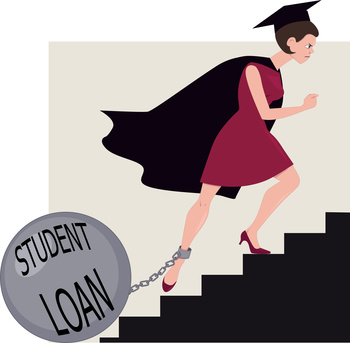
by Otto Baynes
Most types of large loans require you to have significant income and credit history built up to secure them. Student loans are an aberration in the lending world; at age 18 you can begin securing loans in the tens of thousands of dollars with no credit, no collateral, no income and no immediately clear path to repaying them.
Banks have tended to secure student loans at the back end rather than the front, and one central means of doing so has been to lobby the government to not allow them to be discharged through bankruptcy. Up until 1976, it was actually possible to include student loans with other forms of debt in a bankruptcy proceeding. The bankruptcy code was progressively altered from that point forward, first to severely limit the circumstances under which federally-backed loans could be discharged, then eventually to also include private loans in these circumstances as well.
The key words here are “severely limit,” however. Popular belief is that student loans are like tax penalties or child support — there’s simply no way to discharge them in bankruptcy and you’re stuck with them forever. However, that’s not what the law says. It is possible to discharge student loans in a Chapter 7 or 13 bankruptcy if you are experiencing “undue hardship” and can demonstrate that you are unlikely to ever be able to pay them back.
Why Am I Just Now Hearing About This?
So why do so few people actually do it? Because the law is worded very vaguely, and in the end it usually comes down to the interpretation and discretion of each individual judge or appellate panel in each bankruptcy case. It also requires a separate adversary proceeding, which is sort of like a miniature civil suit against the lender that takes place within the bankruptcy. This makes the bankruptcy take extra time and generally requires bringing in a lawyer who is experienced in these matters.
To be blunt, most people won’t be so abjectly low on means of sustenance that they’ll qualify for the court’s definition of “undue hardship.” If the student loans are an undue burden that is contributing to actual financial ruin, however, this course of action may be worth looking into.
The Brunner Test
Since the wording of what constitutes “undue hardship” is left so vague and open to interpretation, successful bankruptcy discharges of student loans generally rely on citing precedent from previous cases. There is one standard test that has been commonly used in many cases across the country. It is called the “Brunner Test,” and it is a simple series of three questions:
- Has the debtor attempted in good faith to make payments on the loan that are within their means?
- Is the debtor’s income so low that forcing them to make the minimum allowed loan payment will interfere with their basic necessary expenses?
- Given the applicant’s current income and likely future prospects, is there a realistic expectation that the loan can ever be fully repaid?
Being able to honestly answer “yes” to the first two questions and “no” to the third means that you have a chance to have your student loans discharged along with the rest of your debt, provided it is a chapter 7 or 13 bankruptcy (no other types allow you to do this.) It will be left up to the appellate panel or the judge to make the final determination, however. If you happen to get a judge who is a big Ayn Rand fan and expects people to get out of trouble by yanking their bootstraps so hard they fly into a higher tax bracket, you may not get your loans discharged even if you have a strong case under the Brunner terms. This is where the help of an experienced bankruptcy lawyer comes in.
Prior Case Law
If you feel like you may be able to do this, the best place to start looking is at prior case law where people were able to get their student loans bundled into their bankruptcy. One central case to look into is Hedlund v. The Educational Resources Institution, which basically established that debtors with student loans should not be expected to live in conditions resembling indentured servitude just to pay off that specific debt. In Re Walker, 406 B.R. 840 is one that is of specific interest to parents, as it establishes that having a large number of children cannot be held against you as a factor in dismissal. And Shaffer v. U.S. Department of Education determined that even if the debtor has the education and experience to potentially make payments in the future, there must be a clear path to such financial stability or the presumption cannot be made that it will just suddenly materialize someday.
These are just a few starting points. Roughly 200 to 300 bankruptcies each year allow the discharge of student loans. This number is so low not because of refusals, but because less than 1% of all those who file for bankruptcy and have student loans even attempt to do it! Naturally, if you never file the adversary proceeding, there is no chance whatsoever that your loans will be discharged.

0 responses so far ↓
There are no comments yet...Kick things off by filling out the form below.
Leave a Comment